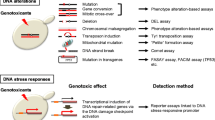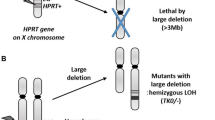Abstract
The mutation rate in cells induced by environmental genotoxic hazards is very low and difficult to detect using traditional cell counting assays. The established genetic toxicity tests currently recognized by regulatory authorities, such as conventional Ames and hypoxanthine guanine phosphoribosyl-transferase (HPRT) assays, are not well suited for higher-throughput screening as they require large amounts of test compounds and are very time consuming. In this study, we developed a novel cell-based assay for quantitative analysis of low numbers of cell copies with HPRT mutation induced by an environmental mutagen. The HPRT gene mutant cells induced by the mutagen were selected by 6-thioguanine (6-TG) and the cell’s kinetic growth curve monitored by a real-time cell electronic sensor (RT-CES) system. When a threshold is set at a certain cell index (CI) level, samples with different initial mutant cell copies take different amounts of time in order for their growth (or CI accumulation) to cross this threshold. The more cells that are initially seeded in the test well, the faster the cell accumulation and therefore the shorter the time required to cross this threshold. Therefore, the culture time period required to cross the threshold of each sample corresponds to the original number of cells in the sample. A mutant cell growth time threshold (MT) value of each sample can be calculated to predict the number of original mutant cells. For mutagenesis determination, the RT-CES assay displayed an equal sensitivity (p > 0.05) and coefficients of variation values with good correlation to conventional HPRT mutagenic assays. Most importantly, the RT-CES mutation assay has a higher throughput than conventional cellular assays.

Quantitative analysis of low copy number mutant cells with cell growth kinetic curves. a Low copy number HPRT gene mutant cells are growning on electronic chip and the cell growth kinetic curve is monitored by a real-time cell electronic sensor (RT-CES) system. b When set up a threshold is set at certain level of cell index (CI), the samples with different initial mutant cell copies take different amounts of time in order for their growth (or CI accumulation) to cross this threshold. A mutant cell growth time threshold (MT) value of each sample can be calculated to predict the number of original mutant cells






Similar content being viewed by others
References
Mosmann T (1983) Rapid colorimetric assay for cellular growth and survival: application to proliferation and cytotoxicity assays. J Immunol Methods 65:55–63
Denizot F, Lang R (1986) Rapid colorimetric assay for cell growth and survival. Modification to the tetrazolium dye procedure giving improved sensitivity and reliability. J Immunol Methods 89:271–277
Xing JZ, Zhu J, Jackson JA, Gabos S, Sun XJ, Wang XB, Xu X (2005) Dynamic monitoring of cytotoxicity on microelectronic sensors. Chem Res Toxicol 18:154–161
Hoffmann GR (1982) Mutagenicity testing in environmental toxicology. Environ Sci Technol 16:560A–574A
Eastmond DA, Hartwig A, Anderson D, Anwar WA, Cimino MC, Dobrev I, Douglas GR, Nohmi T, Phillips DH, Vickers C (2009) Mutagenicity testing for chemical risk assessment: update of the WHO/IPCS Harmonized Scheme. Mutagenesis 24:341–349
Houk VS (1992) The genotoxicity of industrial wastes and effluents—a review. Mutat Res 277:91–138
Claxton LD, Houk VS, Hughes TJ (1998) Genotoxicity of industrial waste and effluents. Mutat Res 410:237–243
Auletta AE, Dearfield KL, Cimino MC (1993) Mutagenicity test schemes and guidelines: US EPA office of pollution prevention and toxics and office of pesticide programs. Environ Mol Mutagen 21:38–45
Jenssen D, Beije B, Ramel C (1979) Mutagenicity testing on chinese hamster V79 cells treated in the in vitro liver perfusion system. Comparative investigation of different in vitro metabolising systems with dimethylnitrosamine and benzo[a]pyrene. Chem Biol Interact 27:27–39
Slameňová D, Gábelová A, Ruppová K (1992) Cytotoxicity and genotoxicity testing of sodium fluoride on Chinese hamster V79 cells and human EUE cells. Mutat Res/Genetic Toxicol 279:109–115
Cole J, Mcgregor DB, Fox M, Thacker J, Garner RC (1990) Gene mutation assays in cultured mammalian cells. In: Kirkland DJ (ed) Basic mutagenicity tests: Ukems recommended procedures. Bath Press, Bath
Cole J, Arlett CF (1984) The detection of gene mutations in cultured mammalian cells. In: Venitt S, Parry JM (eds) Mutagenicity testing—a practical approach. IRL, Oxford, pp 233–273
Nestmann E, Brillinger R, Gilman J, Rudd C, Swierenga S (1991) Recommended protocols based on a survey of current practice in genotoxicity testing laboratories: II. Mutation in Chinese hamster ovary, V79 Chinese hamster lung and L5178Y mouse lymphoma cells. Mutat Res 246:255–284
Buchwald M (1977) Mutagenesis at the ouabain-resistance locus in human diploid fibroblasts. Mutat Res 44:401–412
Oberly TJ, Michaelis KC, Rexroat MA, Bewsey BJ, Garriott ML (1993) A comparison of the CHO/HGPRT+ and the L5178Y/TK+/− mutation assays using suspension treatment and soft agar cloning: results for 10 chemicals. Cell Biol Toxicol 9:243–257
Knight AW, Little S, Houck K, Dix D, Judson R, Richard A, McCarroll N, Akerman G, Yang C, Birrell L, Walmsley RM (2009) Evaluation of high-throughput genotoxicity assays used in profiling the US EPA ToxCastTM chemicals. Regul Toxicol Pharmacol 55:188–199
Xing JZ, Zhu J, Gabos S, Xie L (2006) Microelectronic cell sensor assay for detection of cytotoxicity and prediction of acute toxicity. Toxicol Vitro 20:995–1004
Roa W, Yang X, Guo L, Huang B, Khatibisepehr S, Stephan Gabos S, Chen J, Xing JZ (2011) Real-time cell impedance sensing assay as an alternative to clonogenic assay in evaluating gold nanoparticles enhanced cancer radiotherapy. Anal Bioanal Chem 400:2003–2011
Varnes ME, Biaglow JE (1979) Interactions of the carcinogen 4-nitroquinoline 1-oxide with the non-protein thiols of mammalian cells. Cancer Res 39:2960–2965
Kuroda Y (1996) Bio-antimutagenic activity of green tea catechins in cultured Chinese hamster V79 cells. Mutat Res 361:179–186
Raeymaekers L (2000) Basic principles of quantitative PCR. Mol Biotechnol 15:115–122
Rutledge RG, Stewart D (2008) A kinetic-based sigmoidal model for the polymerase chain reaction and its application to high-capacity absolute quantitative real-time PCR. BMC Biotechnol 8:47
Ruijter JM, Ramakers C, Hoogaars WM, Karlen Y, Bakker O, van den Hoff MJ, Moorman AF (2009) Amplification efficiency: linking baseline and bias in the analysis of quantitative PCR data. Nucleic Acids Res 37(6):E45
Yang L, Arias LR, Lane TS, Yancey MD, Mamouni J (2011) Real-time electrical impedance-based measurement to distinguish oral cancer cells and non-cancer oral epithelial cells. Anal Bioanal Chem 399:1823–1833
Kute TE, Savage L, Stehle JR Jr, Kim-Shapiro JW, Blanks MJ, Wood J, Vaughn JP (2009) Breast tumor cells isolated from in vitro resistance to trastuzumabremain sensitive to trastuzumab anti-tumor effects in vivo and to ADCC killing. Cancer Immunol Immunother 58:1887–1896
Ryder AB, Huang Y, Li H, Zheng M, Wang X, Stratton CW, Xu X, Tang YW (2010) Assessment of Clostridium difficile infections by quantitative detection of tcdB toxin by use of a real-time cell analysis system. J Clin Microbiol 48:4129–4134
Xing JZ, Zhu LJ, Huang B, Chen J, Gabos S (2012) Microelectronic-sensing Assay to detect presence of Verotoxins in human fecal samples. J Appl Microbiol 113:429–437
Acknowledgments
We would like to thank Alberta Health & Wellness for providing the funding for this study. We would also like to thank Mr. Scott MacKay for providing valuable input during the revision of the manuscript.
Author information
Authors and Affiliations
Corresponding author
Electronic supplementary material
Below is the link to the electronic supplementary material.
ESM 1
(PDF 341 KB )
Rights and permissions
About this article
Cite this article
Xing, J.Z., Gabos, S., Huang, B. et al. High-throughput quantitative analysis with cell growth kinetic curves for low copy number mutant cells. Anal Bioanal Chem 404, 2033–2041 (2012). https://doi.org/10.1007/s00216-012-6328-5
Received:
Revised:
Accepted:
Published:
Issue Date:
DOI: https://doi.org/10.1007/s00216-012-6328-5




